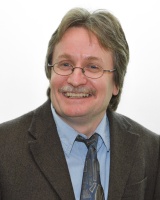
Contact
Dr. Uwe Hommerich
Position: Professor of Physics
Educational Background: B.S. 1986, University of Oldenburg, Germany, M.S. 1990, University of Oldenburg, Germany, Ph.D. 1994, University of Hamburg, Germany, (in collaboration with the University of Georgia, Athens, USA)
Research Interests: Luminescent Materials Development, Laser Spectroscopy, Crystal Growth
The research of my group focuses on the development and characterization of new luminescent materials which are of interest for applications in solid-state lasers, optical amplifiers, light emitting diodes, and phosphors. The advancement of luminescent materials requires a detailed understanding of their properties so that material preparation can be optimized and creative solutions to current limitations can be found. State-of-the-art laser facilities are being employed by us to perform comprehensive optical characterization and device testing of new materials. Material synthesis is being carried out at Hampton University and in cooperative research programs with universities and industry
At present, we are interested in the optical properties of rare earth doped bulk and nano-crystalline materials for photonic applications. For example, a current focus of my research group is the infrared optical properties of rare earth doped low-phonon energy halide crystals for applications as mid-infrared gain media. The non-radiative decay rates of rare earth ions are greatly reduced in low-phonon host materials, which can result in efficient infrared emission at room-temperature. Jointly with our collaborators, we demonstrated efficient mid-infrared emission in the technologically important 3-5 mm region from several rare earth doped potassium lead halide crystals.
More recently, we started a project on infrared laser-induced breakdown spectroscopy (IR-LIBS) for applications in biological and chemical sensing. Jointly with researchers at Brimrose Corporation of America and Edgewood Chemical Biological Center, we demonstrated the first observation of IR LIBS emission signatures in the 3-5 mm region from carbon containing materials, alkali halides, and ammonium compounds. Detailed studies of IR LIBS for applications in environmental monitoring, geological sciences, pharmaceutical industry, monitoring of industrial processes, and homeland security are still in progress.
In teaching, I emphasize the close relations between experiment, theory, and applications of physics. I stress in my classroom, that many technological developments are based on fundamental concepts and principles in physics. I introduce new physical concepts by explaining several of their applications or by using classroom demonstrations and audio-visual equipment. Moreover, I aim to combine lecturing with project-oriented learning and hands-on experimentation.
Selected Publications:
Clayton S.C. Yang, Feng Jin, Sudhir Trivedi, EiEi Brown, Uwe Hömmerich, Jacob Khurgin, and Alan C. Samuels, “Time resolved long-wave infrared laser-induced breakdown spectroscopy (LIBS) of inorganic energetic materials by a rapid LIBS mercury-cadmium-telluride (MCT) linear array system”, Applied Optics, in press.
- Nemes, E. Brown, C.S.C. Yang, U. Hommerich, “Mid Infrared Emission Spectroscopy of Carbon Plasma”, Spectrochimica Acta Part A: Molecular and Biomolecular Spectroscopy, 170, 145-149 (2017).
Ei Ei Brown, Uwe Hömmerich, Althea Bluiett, Courtney Kucera, John Ballato, and Sudhir Trivedi; Near-Infrared and Upconversion Luminescence Properties in Transparent Er doped Yttria Ceramics under ~1.5 mm Excitation, Journal of the American Ceramic Society 97, 2105 (2014).
- Brown, U. Hommerich, C. S.C. Yang, F. Jin, S. B. Trivedi, and A. C. Samuels, “Eye-safe infrared laser-induced breakdown spectroscopy (LIBS) emissions from energetic materials” Proc. SPIE 9824, Chemical, Biological, Nuclear, and Explosives (CBRNE) Sensing XVII, 98241 B (May 13, 2016).
- Culp, B. R. Reddy, S. M. Rao, S. Trivedi, E. Brown, and U. Hommerich, “White light emission studies of dysprosium doped halides”, Proc. SPIE 9744, Optical Components and Materials XIII, 974406 (Feb 24, 2016).
Clayton S.C. Yang, EiEi Brown, Eric Kumi-Barimah, Uwe Hömmerich, Feng Jin, Yingqing Jia, Sudhir Trivedi, Eric A. Decuir Jr, Priyalal S. Wijewarnasuriya, and Alan C. Samuels, “Rapid long-wave infrared laser-induced breakdown spectroscopy measurements using a MCT focal plane array detection system”, Appl. Opt. 54 (33), 9695-9702 (2015).
- Brown, E. Kumi-Barimah, and U. Hömmerich, A.G. Bluiett, S.B. Trivedi; “Material Purification, Crystal Growth, and Spectroscopy of Tm-doped KPb2Cl5 and KPb2Br5 for 2 µm Photonic Applications”, Journal of Crystal Growth 393, 159 (2014).
Clayton S.C. Yang, EiEi Brown, Eric Kumi-Barimah, Uwe H. Hömmerich, Feng Jin, Sudhir B. Trivedi, Alan C. Samuels, A. Peter Snyder, Infrared (1-10 Clayton, MIR-LWIR Infrared (4-12um) Molecular Emission Signatures from Pharmaceuticals using Laser-Induced Breakdown Spectroscopy, Applied Spectroscopy, 68, 226 (2014).
Ei Ei Brown, Uwe Hömmerich, Althea Bluiett, Courtney Kucera, John Ballato, and Sudhir Trivedi; Near-Infrared and Upconversion Luminescence Properties in Transparent Er doped Yttria Ceramics under ~1.5 µm Excitation, Journal of the American Ceramic Society 97, 2105 (2014).
- Brown, C.B. Hanley, U. Hommerich, A.G. Bluiett, and S. B. Trivedi, “Spectroscopic Study of Neodymium doped Potassium Lead Bromide for Mid-Infrared Solid-State Lasers”, J. Lumin 133, 244 (2013).
- Brown, U. Hommerich, T. Yamada, H. Yamane, J.M. Zavada, “Luminescence Spectroscopy of Europium doped Gallium Nitride powder prepared by a Na flux method”, Phys. Status Solidi A 208, 156 (2010).
- Oyebola, U. Hommerich, E. Brown, S.B. Trivedi, A.G. Bluiett, J.M. Zavada, “Growth and Optical Spectroscopy of Ho-doped KPb2Cl5 for Infrared Solid-State Lasers”, Journal of Crystal Growth 312, 1154 (2010).

